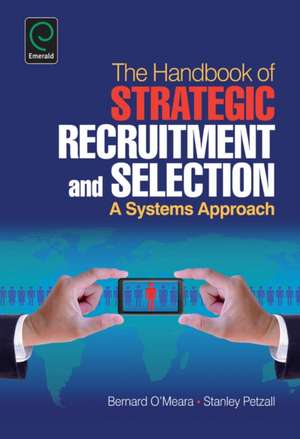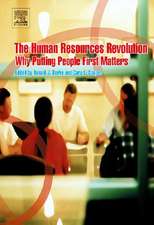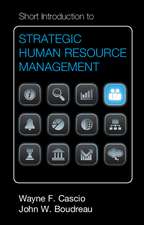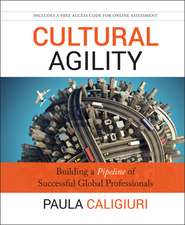Handbook of Strategic Recruitment and Selection – A Systems Approach
Autor Bernard O`meara, Stanley Petzallen Limba Engleză Hardback – 9 dec 2013
Preț: 858.73 lei
Preț vechi: 1115.24 lei
-23% Nou
Puncte Express: 1288
Preț estimativ în valută:
164.34€ • 178.45$ • 138.04£
164.34€ • 178.45$ • 138.04£
Carte tipărită la comandă
Livrare economică 22 aprilie-06 mai
Preluare comenzi: 021 569.72.76
Specificații
ISBN-13: 9781780528106
ISBN-10: 1780528108
Pagini: 476
Ilustrații: illustrations
Dimensiuni: 165 x 240 x 28 mm
Greutate: 0.89 kg
Editura: Emerald Publishing
ISBN-10: 1780528108
Pagini: 476
Ilustrații: illustrations
Dimensiuni: 165 x 240 x 28 mm
Greutate: 0.89 kg
Editura: Emerald Publishing
Notă biografică
Dr Bernard O'Meara is a Senior Lecturer in Human Resources Management at the University of Ballarat, Australia. Dr O'Meara has worked extensively in industry in general management corporate based human resource roles in the manufacturing sector. He has also been principal director of a Melbourne based consulting group. Dr. Stanley Petzall is currently a Senior Lecturer at Deakin Business School, Australia, with 32 years experience of teaching Organisational Behaviour, Human Resource Management, Comparative Management and Business Law in various institutions. He has also consulted with, written distance education materials, and run training programs for a number of organisations, including Associated Securities, Telecom Australia, The Victorian Hospitals Association; and Swinburne Institute of Technology.
Cuprins
About the authors; Acknowledgments; Foreword; Table of contents; How to use this text; Introduction Part 1: Staffing, the Organisation and Recruitment and Selection Chapter 1: Staffing, Systems and Strategy; Staffing; The role and scope of human resource management; Human resource planning; The importance and understanding of staffing excellence; The scope of the staffing function; Strategic staffing: A systems approach (note- definition, goals - ); Traditional approaches to Recruitment and Selection; Recruitment; Selection; Alternatives to Recruitment and Selection; Outsourcing; Leasing; Search/headhunting;Promotion;Horizontal and experiential learning-based transfers; Staff ambassadors; Crowd sourcing Systems theory; What is a system? How systems work; The application of systems theory to recruitment and selection; Alternatives; Benefits Strategy; What is strategy?; Characteristics of strategy; Aligning people and the organisation; Short term needs; Medium term needs; Long term needs; Matching organisation and applicant goals Sustainable staffing; Measuring competencies; The knowledge-based society; Organisational diagnostics; The role of strategic staffing using a systems approach; Review questions; Case study; Further reading Chapter 2: The Organisation The organisation; Culture; Structure; The environment; The organisation & environment interface and links; Maintaining or enhancing the reputation and image of the organisation; Social responsibility and ethics; Preferred employers; VRIO, skill and knowledge analyses and gaps; Succession; The interviewer(s); Review questions; Case study; Further reading Chapter 3: Recruitment and Selection Preparation Role analysis; The purpose of role analysis; Types of analysis; Job descriptions; Person specifications; Selection criteria; 'Must have' criteria; 'Ideally have' criteria; Job redesign opportunities; Transparency; Linking outcomes with other HR functions Internal v external appointments and considerations; Internal and external appointments; The benefits/disadvantages of internal appointments; The benefits/disadvantages of external appointments; Non- traditional sources Advertising; The purpose of advertising; Types of advertising; Creating realistic expectations; The Internet; Social Media Recruitment Preparation; Retention strategies; Human Capital theory Decision making; Subjective techniques, Statistical/objective techniques; Seeking competencies and/or knowledge; The future; The use and role of consultants; Review questions; Case study; Further reading Chapter 4: Communication, Body Language, Questions and interviews Communicating with potential applicants; Cultural considerations; International candidates; Change agents; Social networking; Body language; First impressions; Offsetting bias; Interview environment Questions and questioning techniques; Question techniques; Question types; Legal considerations Interviews; The role and purpose of interviews; Reliability and validity; Active listening; Unskilled interviewers; Competent interviewers; Executive; Insider/Outsider theory; Management; Global; Graduates; Types of interviews; Similarity Attraction theory; On-line hurdles; Applicant tracking; Video resumes; Skype and distance interviewing; Laws impacting upon staffing; Evaluation Review questions; Case study; Further reading Chapter 5: Aids for Recruitment and Selection Recruitment and Selection aids; Psychometrics; The exchange/negotiation perspective; Reliability and validity; Assessment Centres; The use and application of game theory as hurdles; Trial periods; Traditional and non-traditional reference checks; Social networking; Offers; Other considerations; Listing expectations; Direct and indirect discrimination; Review questions; Case study; Further reading Part 2: Applicants and candidates Chapter 6: Applicants and resumes Applicants and candidates; Life experiences; Graduate placements, consulting and internships; Preparing the resume; Traditional resume approaches; Graduates and those with limited work experience; Interview hooks; Research on organisation & industry Cultural differences; Review questions Case study; Further reading Chapter 7: Interview preparationPreparing for the interview; Researching the organisation; Preferred employers; Compatibility; Volunteer work; Review questions; Case study; Further reading Chapter 8: First impressions The first meeting; What employers seek; What applicants seek; Mutual consideration; The 80/20 rule; Eye contact; Nervousness; Review questions; Case study; Further reading Part 3: Joining together: When new employees commence at a new organisation Chapter 9: A new start; Induction; Orientation; Succession; Individual career maps; Training & Development; Enhancing the Learning curve; Motivation and offsetting the leaving of new employees in the first six to twelve months; Retention; Laws impacting upon retention; Review questions; Case study; Further reading Chapter 10: Recruitment and selection costs The costs of recruitment and selection; The cost of getting it wrong; Cost justification for effective and strategic R Recruitment and selection budgets; Review questions; Case study; Further reading Chapter 11: The kaizen requirement Feedback loops; Evaluating performance and 'fit'; Human resource information systems; Fixing it! Continual improvement (Kaizen); Review questions; Case study; Further reading Chapter 12: Evaluation Evaluating the recruitment and selection campaign; Facing future challenges; Review questions; Case study; Further reading Appendixes Glossary Index
Recenzii
"This book captures the essence of attracting and hiring a productive workforce. It presents conceptually strong arguments for effectively incorporating hiring in strategic formulations with excellent embellishments in an easy-to-read fashion - comprising excellent cases and analogies. The content has been eagerly researched and documented, and contains practical advice not only for academia but also for any professional who is concerned with attracting and hiring the best human capital. Throughout the book, the authors never lose sight of the big picture that people are the greatest assets for any organization and identifying, attracting and hiring them is the biggest challenge that confronts businesses worldwide. I have been pleasantly surprised with the eye-to-detail on part of the authors. The content is not only comprehensive but very relevant and contemporary. The readers of this book would be indeed enriched. An excellent resource and a must read for all practitioners and academics interested in garnering the most from strategic recruitment and selection. 'The Handbook of Strategic Recruitment and Selection: A Systems Approach' isn't just a good book - it's THE RIGHT BOOK!" Dr. Debashish Sengupta, Alliance School of Business, Alliance University, Bangalore "A long awaited new wave of ideas and significant contribution to Recruitment and Selection." Vijay Kumar Thambimuthu, Qualifications and Assessments International, (QAI) U.K.












